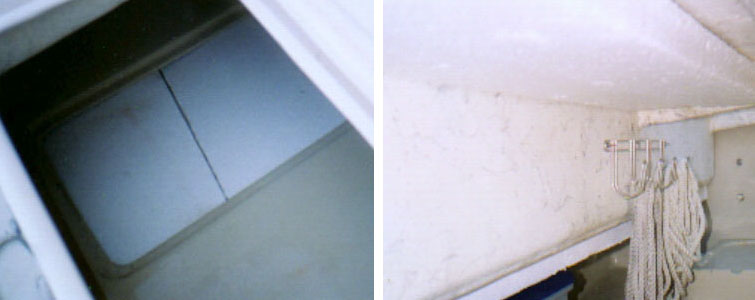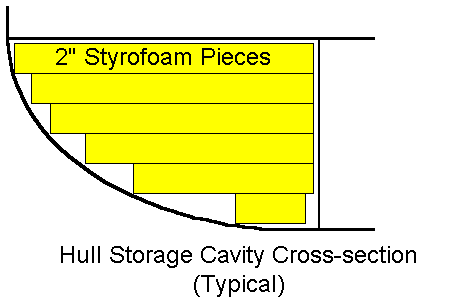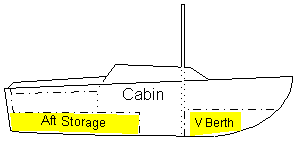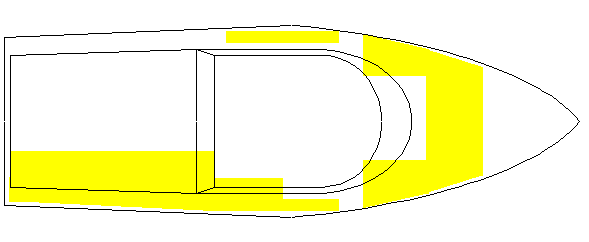

Back to Projects Completed Back to Technical Tips Home
The boat did not have any built-in flotation, so I wanted to add flotation to my Catalina in order to insure its ability to remain afloat during an 'unplanned event'. I did the following calculations to determine how much flotation would be necessary and how much it would cost.
The Figuring . . . One Cubic foot of water weighs 62.4 pounds (salt water = 64 lbs/cu. ft.). The boat will displace an amount of water equal to its weight in order to float. If the hull were not water tight or in its upright position, it would need to rely on the material in the boat for displacement of enough water to float. Given that the boat is mostly fiberglass, and fiberglass is heavier than water, the boat full of water would not float.
Flotation in boats is usually achieved by creating foam filled chambers in the hull structure that will displace enough water to equal the weight of the boat. I would add foam to my Catalina 22 to achieve the additional displacement needed to float the boat.
How much water needs to be displaced by the boat?
Boat Displacement (i.e. its weight) = 2,250 lbs. Typical Gear = 250 lbs.
Total Weight = 2,500 lbs. / 62.4 lbs. Per cubic foot = 40 cubic feet
How much does the boat itself displace?
I originally estimated that the boat would displace about 8 cubic feet if were submerged under water. I needed to add the difference. (40 cu. ft. – 8 cu. ft) = 32 cubic feet. I subsequently came accross a piece of information that leads to a more accurate estimate of the displacement . . . 1 cubic foot of fiberglass weighs approximately 125 lbs. I used this figure to more accurately estimate the displacement of the materials that makes up my boat. Simplifying things, I considered that the total weight of the boat is either fiberglass or ballast, I then took the overall weight of the boat, subtracted the ballast, and that is the fiberglass. I computed a displacement for the materials in the boat and keel (ballast) separately.
The volume of the boat materials was figured based on their approximate weight: 2,250 lbs. - 550 lbs. = 1700 lbs. (weight of the fiberglass).
It will displace 1700 lbs./125 lbs per cu. ft.= 13.6 cubic feet.
I figured the keel based on its dimensions; it is approximately 2"x12"x60" =1,440 cubic inches = 0.8 cubic foot.
The total boat (fiberglass & keel) will displace (13.6 + 0.8) = 14.4 cubic feet.
The 32 cubic feet of flotation added, plus the 14.4 cubic feet estimated for the boat itself equals 46.4 cubic feet total. This means that the total bouyancy (if totally submerged) would be (46.4 cu. ft. x 62.4 lbs./cu. ft.) = 2,900 lbs. Given that the boat weighs 2,250 lbs., the extra 650 lbs. of reserve flotation should be plenty for the gear and crew members.
The 32 cubic feet of foam being added to the boat would be a ‘piece’ measuring 8’ x 1’ x 4’. This would (obviously) not fit into the boat as a single piece, but an equivalent amount needs to be distributed throughout the interior of the boat.
What kind of foam should be used?
Economics come into play here in a big way. There are pour-in foam kits available at local marine centers, but the cost ($30/cubic foot) is prohibitive (almost $1,000 in this case). I chose a less expensive alternative from the local building supply – rigid styrofoam – which is usually sold for home insulation ($2.25/cubic foot). I also bought a few cans of expanding foam insulation (like "Great Stuff") for filling in odd shapes and as an adhesive.
How do I know the foam will work?
I made sure to use a "Closed Cell" foam, as some foam products can actually absorb water , and will not provide the intended flotation (these are "Open Cell" foams). The commonly available white styro-foam (that is made from compressed foam beads) is probably the best material to use. I submerged a piece of the foam in water overnight to determine its suitability as flotation. My hopes were that in the morning it would not have absorbed any appreciable amount of water (other than surface dampness), and would float freely on the top of the water as it did the day before. The foam in question passed this test, so I figured it was suitable for use as flotation in my boat.
Where are you going to put 32 cubic feet of foam?
This would be a challenge, but the boat has lots of storage space and plenty of nooks and crannies to house the foam. There is a fairly large storage area in the V-berth, and the stern has cavernous storage. I sacrificed the V-berth storage and a marginally accessible area in the stern to the cause, the rest would have to come from various areas throughout the boat.
The pictures /diagrams below show where I put 32 cubic feet of styrofoam in a 22 foot boat.
 |
| The V-Berth storage is completely filled with foam; there is a small access hole to allow inspection and bilge pumping (above left). Many of the storage areas are padded with foam - this gives good distribution of floatation without appreciably reducing storage space (above right - foam shaped to the contour of the hull in the storage space below the starboard settee). |
 |
| The marginally accessible area in the starboard stern is completely filled with foam, as viewed from the cockpit storage compartment (above left).The main storage area in the stern has several pieces of foam glued to the ceiling, using "Great Stuff " as an adhesive (above right). |
Installation Diagrams

General Areas Where I Installed Floatation (indicated in yellow)

1) Side View showing areas in the stern and the V-berth where I inserted floatation.

2) Overhead view of Stern and V-berth storage areas.
I was even able to insert some foam in the space between the cabin side wall and the hull. In total, 32 cubic feet of foam was hidden away in the boat without appreciable loss in storage space.